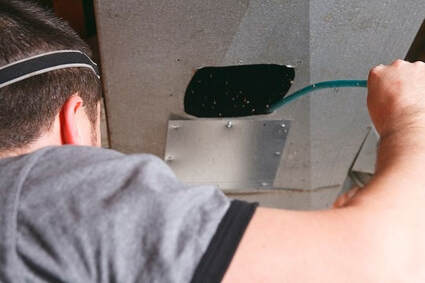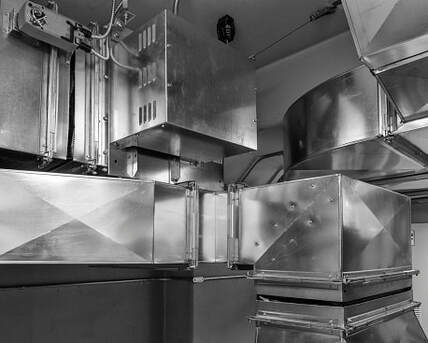 If you came across this article as a result of an internet search, you may have noticed there aren't a lot of search results for "furnace duct cleaning." It’s not a conspiracy but rather a matter of diction: the more common term is “air duct cleaning.” The process is also sometimes referred to as “HVAC duct cleaning” or “vent cleaning.” Furnace duct cleaning—or air duct cleaning—is the process of removing contaminants and debris from the ductwork associated with the HVAC (Heating, Ventilation, and Air Conditioning) system. This ductwork is sometimes referred to as furnace ducts because they originate at the furnace—the heat source—and serve to distribute heated (or, in some cases, cooled) air throughout the building or home, exiting at the vents or diffusers. What is the process for furnace duct cleaning? There are a variety of methods for cleaning furnace ducts, but generally the process relies on a dual approach, referred to as the “push and pull method.” The first aspect relies on a powerful vacuum applied near the furnace to create negative pressure, or sucking in of the debris to a containment system, preferably off-site, such as a truck. The second aspect of the service involves the utilization of agitation equipment, such as pneumatic air whips or rotating brushes, which essentially jostle around inside the ducts and loosen any debris, which is then sucked up by the vacuum. Still have questions about the cleaning process or the various levels available? Visit our air duct cleaning service page. What is the difference between furnace duct cleaning and air duct cleaning? In short, nothing at all. Some companies that refer to their service as “furnace duct cleaning” rather than “air duct cleaning” may perhaps do so because they include the furnace as part of the duct cleaning process. Since the furnace and ductwork are all connected and continuously circulate air throughout the system, if one component is dirty and in need of cleaning, the other likely is too—so cleaning the furnace along with the furnace ducts is almost always the best approach (unless, as happens every so often, customers are having their ducts cleaned because they’re getting their furnace replaced). Always check with the company, though, to find out what components are included during the cleaning service, as it is not necessarily standard practice to include the furnace in an air duct cleaning without additional cost. Where can I find out more? Now familiar with the lingo, you’ll find a wellspring of information available in a search for “air duct cleaning.” Interested in finding out what tools are used during the process? Check out our blog article, Tools and Equipment Used During Air Duct Cleaning. Want to read about each of the specific levels of service available and the precise process it entails? Visit our air duct cleaning service pages. Considering having the service performed? Download our free tipsheet: 10 Questions to Ask Before Hiring an Air Duct Cleaning Company.
0 Comments
 What is HVAC Cleaning? HVAC (Heating, Ventilation, and Air Conditioning) cleaning involves the removal of dirt, debris, and contaminants from the individual components of a building’s HVAC system, either in a residential or commercial setting. In a residential setting, these components would likely include the furnace (including the blower wheel), supply and return ductwork, evaporator coil (A-coil), etc. Commercial components cleaned would include the air handling unit (AHU) or rooftop unit (RTU), supply and return ducts, coils, VAV boxes, supply diffusers and return grilles, etc. How is the HVAC System Cleaned? Each of the various HVAC components calls for a different method of cleaning. Air duct cleaning is typically accomplished with the application of high-pressured air and/or whips or brushes that physically sweep debris from the ducts, in combination with negative pressure in the form of a vacuum to capture debris and contain it off-site. Furnaces are typically cleaned using mostly air pressure, with some parts (e.g. flame sensor) being physically wiped down. For the evaporator coil, light brushing with air pressure (so as not to bend the delicate aluminum fins) and possibly the application of a cleaning solution is typical. In some cases, the coil may be removed completely and washed outside (a process that would command a higher labor cost). The outside AC condenser unit, which also requires routine maintenance, can be cleaned of leaves and other outdoor debris with the application of air pressure and water, often from a garden hose. The homeowner should make sure surrounding foliage is trimmed regularly. For commercial HVAC cleaning jobs, an on-site assessment will determine the most appropriate cleaning method, which, regarding the ducts, could involve anything from the use of air whips/power brushes and contact vacuuming to a physical crawl-through by the technician. Air handler components may be cleaned with high-pressured air, surface cleaning, or air whips, depending on their size and how much access is available. A walk-in handler would be cleaned using a pressure washer and wet-vac. Grilles, grates, and diffusers are usually hand-wiped and ideally degreased. Why is HVAC Cleaning Necessary? It’s all about air flow—to ensure proper operation and efficiency of the HVAC system and all of its parts. If the filter is dirty, air flow is restricted. If the blower wheel is dirty, air flow is restricted—you get the idea. If all the system components are clean (barring any repair issues), you can feel confident your system is running at top efficiency. In a commercial environment, again, having clean VAV boxes, coils, and dampers allows air to flow to its destination unhindered. But it’s also about indoor air quality. Air moving through a dirty HVAC system is going to pollute the indoor environment. To save your family (or your employees) the discomfort and ill effects of breathing contaminated indoor air, investment should be made in regular system cleaning. Additionally, when the visible components of the system (vent covers, grilles, grates, diffusers) sparkle, occupants can have confidence in the overall cleanliness of the HVAC system and the air it circulates. Many of us have probably experienced the unsettling feeling of wanting to hold our breath at the sight of blowing dust-bunnies clinging to filthy air vents! When Should the HVAC System be Cleaned? For commercial cleaning jobs, the suggestion would be every 5 to 10 years. Most commercial cleaning companies will send a technician to the property at no cost to assess the system and discuss project scope and overall cost. For residential jobs, the general guideline would be every one to three years, as well as after any disruptive event such as laying new carpet, polishing/sanding wood, remodeling (particularly if drywall is involved), etc. Basically, conditions that tend to generate debris would warrant more frequent HVAC cleaning. Or, in the frank words of one of our technicians, “If they’re running a cat hotel, they probably want to have their system cleaned yearly.” A good rule of thumb: if the appearance of the ceiling tiles, vents, or diffusers is unsightly, then it’s fair to question whether the cleanliness of the system is compromised and you should consider having it assessed for cleaning. How Much Does HVAC Cleaning Cost? Cost and quality will vary greatly among companies. For residential jobs, furnace cleaning will generally range from $50 to $500, with the (much) higher price range presumably including the evaporator coil—the cleaning of which can be quite labor intensive. For air duct cleaning, HomeAdvisor calculates the range nationally at between $120 and $675. Factors that increase the cost of the service would include having more than one system, the size of the home, and the level of service desired. The main thing to bear in mind when considering the cost of services is whether there may be any charges you haven’t considered, or, more nefariously, hidden costs. During your conversation with the company while you are in the consideration phase, ask questions designed to flesh out these possibilities, such as “Is there anything that may increase the cost of the service that I haven’t considered?” Or more directly, “Are there any hidden costs?” On the flip side, ask also if there are any discounts for first-time customers, subscribers to the company newsletter, online booking discount, etc. Many companies offer these types of incentives. Now that you’re familiar with HVAC basics, feel free to dig deeper by exploring some of our HVAC cleaning service pages, including a detailed description of the cleaning process and pricing. Many thanks to our technicians Roy S. and Ben S. for lending their expertise to this article. |
SearchArchives
April 2022
|
Twin Cities Furnace Cleaning - Open 7 Days a Week 8AM to 8PM
